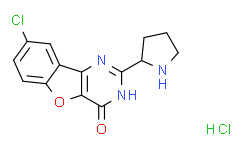| Description: |
XL413 hydrochloride is a potent, selective and ATP competitive inhibitor of Cdc7, with an IC50 of 3.4 nM, and also shows potent effect with IC50s of 215, 42 nM on CK2, PIM1, respectively, and an EC50 of 118 nM on pMCM. |
| In Vivo: |
XL413 (100 mg/kg, p.o.) shows excellent plasma exposures in mice and possesses good PK properties. XL413 (10, 30, or 100 mg/kg, p.o.) is well tolerated at all the doses, with no significant body weight loss[1]. |
| In Vitro: |
XL413 hydrochloride is a potent, selective and ATP competitive inhibitor of Cdc7, with an IC50 of 3.4 nM, and also shows potent effect with IC50s of 215, 42 nM on CK2, PIM1, respectively, and an EC50 of 118 nM on pMCM. |
| Kinase Assay: |
20 ng of purified human DDK is pre-incubated with increasing concentrations of each DDK inhibitor for 5 min. Then 10 μCi (γ)-32P ATP and 1.5 μM cold ATP are added in a buffer containing 50 mM Tris-HCl (pH 7.5), 10 mM MgCl2, and 1 mM DTT and incubated for 30 min at 30°C. The proteins are denatured in 1X Laemmli buffer at 100°C followed by SDS-PAGE and autoradiography on HyBlot CL film. Auto-phosphorylation of DDK is used as an indicator of its kinase activity. 32P-labeled bands are quantified using ImageJ and the IC50 values are calculated using GraphPad. |
| Cell Assay: |
For assays in 96 well plates 2500 cells are plated per well. After 24 hours, cells are treated with small molecule inhibitors and incubated for 72 hours at 37°C. Subsequently the cells are lysed and the ATP content is measured as an indicator of metabolically active cells using the CellTiter-Glo assay. IC50 values are calculated using the GraphPad software. For assays in six well plates, 100,000 cells are plated per well. After 24 hours, cells are treated with small molecule inhibitors and incubated for varying time points. Cells are trypsinized and a suspension is made in 5 mL of phosphate buffered saline. 30 μL of this suspension is mixed with 30 μL of CellTiter-Glo reagent followed by a 10-minute incubation at room temperature. Luminescence is measured using EnVision 2104 Multilabel Reader and BioTek Synergy Neo Microplate Reader. |
| References: |
[1]. Koltun ES, et al. Discovery of XL413, a potent and selective CDC7 inhibitor. Bioorg Med Chem Lett. 2012 Jun 1;22(11):3727-31.
[2]. Sasi NK, et al. The potent Cdc7-Dbf4 (DDK) kinase inhibitor XL413 has limited activity in many cancer cell lines and discovery of potential new DDK inhibitor scaffolds. PLoS One. 2014 Nov 20;9(11):e113300. |






















